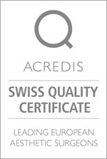Water-jet fat transfer
Crucial: gentle liposuction
Only intact fat cells are suitable for a fat transplant. Thus, it is absolutely critical for a successful fat transplant that a technique of fat retrieval is used that is gentle to the fat cells mechanically, chemically and thermally. Liposuction methods using ultrasound, laser or vibration are out of the question, because with these methods the walls of the fat cells are destroyed. With water jet assisted liposuction using Body-Jet™, a preheated fluid containing a cell-preserving anesthetic agent is introduced into the fat tissue using a cannula with a flat tip. The gentle stream loosens the fat layer and enables the fat cells to be removed gently. Important structures such as blood vessels, nerves or lymph vessels are pushed aside by the spray, so to speak, and are thus protected from mechanical injury. One can designate water jet assisted liposuction as an indirect process: it is less of a suction and more of a flushing out. The fat cells are flushed out of the connective tissue layer and suctioned with a weak, tissue-protective negative pressure. Thus, over 90% of the fat cells removed are intact and can be transplanted.
Fat processing
After passing through a filter sieve, where larger, unnecessary tissue parts are eliminated, the fat cells are put into a sterile collection vessel (AquaShape LipoCollector™). The fat cells are separated from the fluid as a result of buoyancy and gravity, and the separation process is completed through a fine filter, so a centrifuge is not required. This system separates and cleans the fat immediately after the suctioning. At the end of this cleaning process there remains a clean, transplantable and ready to use autogenous fat. The fat can then be withdrawn from the collection vessel using a special cannula in such a way that there is no contact with air and hence no contamination risk. This is another critical requirement so that as many fat cells as possible “survive” the transfer. Studies have shown that the fat cells retrieved in this way must be transplanted within 6 hours so that they survive. Since the fat transfer takes place immediately following the suctioning, this term is met easily.
Fat infiltration
The fat is then transplanted directly using a syringe: using a fine, blunt tip cannula equipped with lateral openings and attached to the syringe, the fat cells are carefully and evenly sprayed into the tissue without great pressure. The survival of the fat cells is dependent on their ability to connect with good tissue with ample blood supply as quickly as possible. Thus, fat can’t be transplanted in large clumps, but rather the individual fat cells must be distributed evenly throughout the tissue in a bead-like manner (for comparison, when you seed a lawn, the seeds must be finely and evenly distributed, since a pile of grass seed will not grow). For this reason there is a limit to how much volume increase is possible in a session. It is also important that the cells do not cool off and are not subject to pressure.
The anesthesia

Liposuction is ideally conducted under local anesthetic. Before the actual suction phase, the anesthetic fluid, preheated to body temperature is introduced into the treatment targeted fat layer beneath the skin using a very fine infiltration cannula. Depending on the situation, the power of the pulsing, fan-shaped spray emitted from the cannula tip varies. This guarantees a tissue-protecting process, generally with minimal pain.
The anesthetic fluid contains an immediately effective local anesthesia (50ml lidocaine per liter), a anesthetic with long term effectiveness (10ml naropin per liter) as well as a vasoconstrictive drug (1ml adrenalin per liter), which both inhibits bleeding and prevents the fluid from unnecessarily entering the body. Added to this is bicarbonate to neutralize as well as cortisone as an anti-inflammatory drug.




